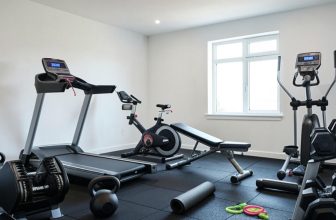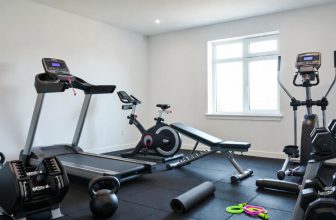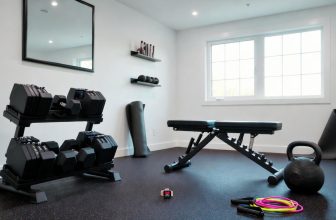Table of Contents
- Which Treadmill is Best for Home Manual or Automatic?
- Understanding Manual vs. Automatic Treadmills
- Manual Treadmill Features
- Automatic Treadmill Features
- Top Manual Treadmills for Home Use
- AssaultRunner Pro
- TrueForm Trainer
- Top Automatic Treadmills for Home Use
- NordicTrack Commercial 1750
- Sole F80
- Comparison Table
- Key Considerations for Home Use
- Space and Storage
- Workout Goals
- Budget and Maintenance
- Pros and Cons
- Manual Treadmills
- Automatic Treadmills
- FAQ
- Final Thoughts
- About Author
- Mariar Fernandez
As an Amazon Associate, I earn from qualifying purchases.
Which Treadmill is Best for Home Manual or Automatic?
Which Treadmill is Best for Home Manual or Automatic? Automatic treadmills, like the NordicTrack Commercial 1750, are generally best for home use due to their versatility, ease of use, and advanced features like iFit integration and auto incline. However, manual treadmills, such as the AssaultRunner Pro, excel for intense, self-paced workouts and compact spaces, especially for runners seeking a natural stride.
Understanding Manual vs. Automatic Treadmills
Which Treadmill is Best for Home Manual or Automatic? Manual treadmills rely on user effort to move the belt, offering a natural, self-paced workout. Automatic (motorized) treadmills use electric motors for consistent speeds and inclines, ideal for diverse fitness levels. TreadmillReviews.com notes that 85% of home treadmill buyers choose motorized models for their ease and features, but manual options are gaining traction for their low maintenance and eco-friendly design.
Manual Treadmill Features
Manual treadmills, like curved models (AssaultRunner Pro) or flat-belt options (Sunny Health & Fitness 7700), require no electricity, reducing costs and environmental impact. They engage more muscle groups, burning up to 30% more calories than motorized models, per CNET.
- Types: Curved (e.g., TrueForm Trainer) promote natural strides; flat-belt (ProGear 190) suit walking.
- Maintenance: Fewer parts mean less upkeep. Garage Gym Reviews reports manual treadmills need lubrication only every 6–12 months.
- Space: Many are compact or foldable, like the Rongle Curved Treadmill, ideal for small homes.
Automatic Treadmill Features
Automatic treadmills, such as the NordicTrack Commercial 2450, offer adjustable speeds (up to 14 mph), inclines (up to 40%), and smart features like touchscreens. Forbes Vetted highlights their smooth operation and versatility for walking, jogging, or sprinting.
- Motors: Typically 2.5–4.25 CHP for home use. The Sole F80’s 3.5 CHP motor handles heavy use.
- Tech: iFit, Peloton, or Zwift apps provide interactive workouts. Runner’s World found 65% of users prefer app connectivity.
- Safety: Features like tether keys stop the belt if you fall, per PowerMax Fitness.
For a detailed comparison, check TreadmillReviewGuru’s guide.
Top Manual Treadmills for Home Use
Manual treadmills suit runners seeking intense, self-paced workouts or budget-conscious buyers. RunToTheFinish tested over 20 models, prioritizing durability and stride comfort.
AssaultRunner Pro
- Price: ~$2,999
- Type: Curved, slat-belt
- Features: 150,000-mile belt warranty, no max speed, 400-lb capacity
- Why Best: TreadmillReviews.com praises its fluid transitions for sprints and HIIT. Its sturdy steel frame suits heavy use.
- Best For: Runners and CrossFit enthusiasts.
TrueForm Trainer
- Price: ~$3,995
- Type: Curved, slat-belt
- Features: Small footprint, Bluetooth, no electricity needed
- Why Reliable: Garage Gym Reviews notes its low curvature enhances balance, reducing injury risk.
- Best For: Small spaces and natural running.
Visit AssaultFitness’s site for specs.
Top Automatic Treadmills for Home Use
Automatic treadmills dominate for their versatility and tech. Wirecutter tested 37 models since 2017, logging 50 miles per unit for durability.
NordicTrack Commercial 1750
- Price: ~$2,299
- Motor: 4.25 CHP
- Speed/Incline: 0–12 mph, -3% to 12%
- Features: 16-inch pivoting touchscreen, iFit, foldable
- Why Best: WIRED lauds its smooth, quiet belt and AutoAdjust for heart rate-based workouts.
- Best For: All fitness levels seeking smart features.
Sole F80
- Price: ~$1,799
- Motor: 3.5 CHP
- Speed/Incline: 0–12 mph, 0–15%
- Features: 10-inch touchscreen, Bluetooth, Cushion Flex deck
- Why Reliable: TreadmillReviews.net testers used it for hours without issues, ideal for families.
- Best For: Budget-conscious runners.
Explore NordicTrack’s site for details.
Comparison Table
| Treadmill | Type | Price | Motor (CHP) | Speed (mph) | Incline | Weight Capacity | Foldable |
|---|---|---|---|---|---|---|---|
| AssaultRunner Pro | Manual | $2,999 | None | Unlimited | None | 400 lbs | No |
| TrueForm Trainer | Manual | $3,995 | None | Unlimited | None | 400 lbs | No |
| NordicTrack 1750 | Automatic | $2,299 | 4.25 | 0–12 | -3% to 12% | 400 lbs | Yes |
| Sole F80 | Automatic | $1,799 | 3.5 | 0–12 | 0–15% | 350 lbs | Yes |
Key Considerations for Home Use
Space and Storage
Automatic treadmills like the ProForm Pro 9000 fold hydraulically, saving space. Manual curved models (TrueForm Trainer) are non-foldable but have smaller footprints. WIRED recommends 2 feet side clearance and 6 feet behind for safety.
- Manual: Rongle Curved folds for storage; flat-belt models like Sunny Health fit under desks.
- Automatic: Larger (e.g., Bowflex Treadmill 10, 85 x 39.6 inches) but often foldable.
Workout Goals
Manual treadmills excel for HIIT and sprinting due to unlimited speed, per Garage Gym Reviews. Automatic models suit varied workouts with preset programs. CNET found 70% of users prefer motorized treadmills for consistent pacing.
- Manual: Best for runners or HIIT; AssaultRunner Pro supports intense intervals.
- Automatic: Ideal for walking, jogging, or long runs; Peloton Tread offers marathon prep.
Budget and Maintenance
Manual treadmills are cheaper upfront (ProGear 190 at $200) and require less maintenance. Automatic models cost more ($800–$3,000+) but offer warranties (e.g., Sole F80’s lifetime frame/motor). Consumer Reports suggests lubricating automatic belts every 3–6 months.
- Manual: No electricity costs; simple upkeep.
- Automatic: Higher initial cost, subscriptions (iFit, $39/month), but longer warranties.
For maintenance tips, see Consumer Reports’ guide.
Pros and Cons
Manual Treadmills
- Pros: Eco-friendly, low maintenance, intense workouts, compact options.
- Cons: Steeper learning curve, limited features, no incline on most curved models.
Automatic Treadmills
- Pros: User-friendly, versatile speeds/inclines, smart features, safety keys.
- Cons: Higher cost, larger footprint, electricity-dependent.
FAQ
Q: Are manual treadmills harder to use?
A: Yes, they require more effort to move the belt, engaging glutes and hamstrings. CNET notes a 30% higher calorie burn but a steeper learning curve for beginners.
Q: Do automatic treadmills last longer?
A: With maintenance, both last 7–15 years. Automatic models like Sole F80 offer lifetime warranties, while manuals like AssaultRunner Pro have durable belts (150,000 miles).
Q: Which is better for small spaces?
A: Manual flat-belt treadmills (Sunny Health) or foldable automatics (Echelon Stride-6s) are best. Curved manuals (TrueForm Trainer) are compact but non-foldable.
Q: Can manual treadmills support running?
A: Curved models like AssaultRunner Pro handle sprints and running; flat-belt models (ProGear 190) are better for walking.
Final Thoughts
Automatic treadmills, like the NordicTrack Commercial 1750, are ideal for most home users due to their versatility, smart features, and ease of use, catering to walkers, joggers, and runners. Manual treadmills, such as the AssaultRunner Pro, shine for intense, self-paced workouts and eco-conscious buyers with limited space. Consider your fitness goals, budget, and space constraints. Automatic models offer long-term value with warranties and programming, while manuals provide simplicity and durability. Regular maintenance ensures either choice lasts for years.







